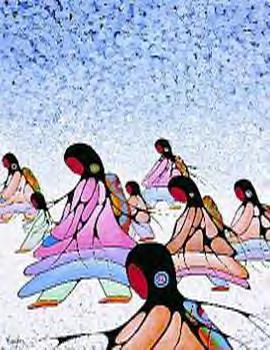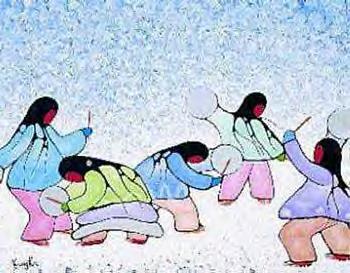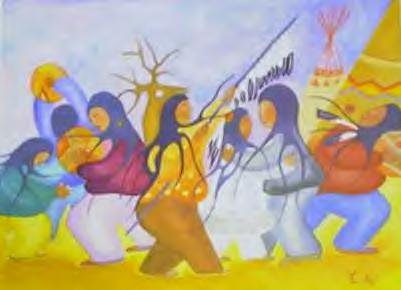|
 FAIRBANKS,
Alaska—When the automatic glass door to Fairbanks International Airport slid open, Maggie Benally, a Navajo language
teacher from Fort Defiance, Arizona, stepped outside the terminal. She slowly glanced around the brightly lit landscape
and looked at her watch. “It is 2:30,” she whispered. “Where are all the people and automobiles?” FAIRBANKS,
Alaska—When the automatic glass door to Fairbanks International Airport slid open, Maggie Benally, a Navajo language
teacher from Fort Defiance, Arizona, stepped outside the terminal. She slowly glanced around the brightly lit landscape
and looked at her watch. “It is 2:30,” she whispered. “Where are all the people and automobiles?”
“Yeah, 2:30 in the morning,” replied one of her companions, Wilfreda Allen. “Even here in the land of midnight
sun, we’ll probably not see much going on at this early hour.”
Benally and Allen were part of a Navajo delegation that visited Alaska this summer to meet some Athabascan cousins
who reportedly are having success in increasing student achievement by building upon the culture of their local
communities.
For over a century, Navajo students depended upon a pedagogy or system of learning primarily limited to Western
European values and worldviews. Many Navajos today feel this system is responsible for the loss of their language
and traditional values. They now seek to improve upon the old system by including language, culture, and the experiences
children bring to school from their local communities.
“We have been hearing about things our brothers and sisters are doing up there in Alaska,” said Genevieve Jackson,
director of the Navajo Nation’s Division of Education. “We are particularly interested in how they are embedding
culture into their curriculum and what they are doing with their Academy of Elders.”
Jackson also said that the Dine Division of Education was planning to consolidate all educational programs into
the Tribal Education Department in order to design a system that combined both Western education and traditional
Navajo ways. “We are building the capacity to address our education needs through our Learn in Beauty Project and
the Navajo Nation’s Rural Systemic Initiative,” she said.
After a few hours of sleep in the sunshine, the six cheechakos, as new arrivals are called in Alaska, met with
Dr. Ray Barnhardt, director of the Center for Cross-Cultural Studies at the University of Alaska. With more than
30 years of experience with Alaska natives, Barnhardt has a well-deserved “sourdough” status that signifies he
knows his way around, up here in The Last Frontier.
Barnhardt shared curriculum materials and books produced by the Alaska Native Knowledge Network with the educators.
He discussed the Alaska Academic Standards and said that standards essentially depict “the destination” deemed
desirable for all students in the state. “Curriculum is the means of getting to the destinations spelled out in
the standards,” Barnhardt explained.
“Each school is responsible for developing a local curriculum to assist their students to achieve the state’s academic
standards,” Barnhardt added. Barnhardt also introduced the visitors to the Guidelines for Preparing Culturally
Responsive Teachers for Alaska’s Schools and the Alaska Standards for Culturally Responsive Schools. These materials
were adopted by the Assembly of Alaska Native Educators in l999.
“Culture standards are meant to enrich the academic standards and provide guidelines for nurturing students in
the rich and varied cultural traditions that continue to be practiced in communities throughout Alaska,” Barnhardt
explained. “They provide schools and communities with an instrument to examine the extent to which they are attending
to the educational and cultural well-being of their students.”
 “We are not advocating that the schools teach culture as an isolated subject, but that it serves
as the foundation for teaching all subjects,” Barnhardt said. “We are suggesting that teachers connect students
to the curriculum by building upon the experiences that they bring to school from their local communities.” “We are not advocating that the schools teach culture as an isolated subject, but that it serves
as the foundation for teaching all subjects,” Barnhardt said. “We are suggesting that teachers connect students
to the curriculum by building upon the experiences that they bring to school from their local communities.”
“Culture standards,” Barnhardt pointed out, “are not intended to be a recipe or formula for schools to follow,
nor do they call for any sort of standardization. They are more like a matrix or model that can be followed by
local schools.”
Barnhardt said that for the past three years they have been tracking student achievement to compare schools that
are implementing the cultural standards with those that are not. “Schools that have been using the local culture
as the foundation for the curriculum have been showing a slow but steady improvement in standardized test scores,
while the other schools have stayed the same or declined,” Barnhardt.
The new pedagogy that Barnhardt explained is called “place-based learning,” said Rosita Murphy, director of the
Learn in Beauty Project for the Navajo Nation. “It builds upon their experiences in their local communities, helps
instill confidence in the students and gives them a sense of place,” Murphy added.
The Learn in Beauty Project is funded by a grant from the Annenberg Foundation’s Rural School and Community Trust,
and has school sites in Tuba City, Window Rock, Newcomb, Ganado, Chinle, Rock Point, and Little Singer. Each site
has its own unique project that addresses a local need. Each site shares its experiences with other schools similarly
situated.
Dr. Joseph Martin, an associate professor at Northern Arizona University and a founding board member of the Rural
School and Community Trust said that Navajo schools are venerable local institutions able to help local Navajo
communities face their problems. Their mission is often seen only as preparing Navajo children for life elsewhere
and too many schools do not even do that well. “They teach Navajo children that leaving is expected of them, and
schools help send them off without a sense of the place they have come from, or respect for the idea of reservation-community
itself.” Martin said. Martin, a former school superintendent, said that if he had an opportunity to serve as a
school superintendent all over again he would place more emphasis on building a school program “that links academic
excellence with a sense of place and respect for local-reservation community.”
The Learn in Beauty Project works closely with the Navajo Nation’s Rural Systemic Initiative. This initiative was
funded by the National Science Foundation to increase academic achievement in math, science and technology. Dr.
Rachel Misra, director of the NN-RSI, said she was pleased with what she saw going on in Alaska. “They have been
building upon thousands of years of learning to live in their environment with remarkable success.”
 “We can learn a lot from our ‘cousins’ up here in Alaska,” said Elsie Carr, a curriculum development
specialist for the Tuba City School District. “When I discovered their web site (www.ankn.uaf.edu) I had to get
up here to see what they were doing.” Carr said that Navajos and Athabascans have much in common, such as the need
to preserve and build upon the wisdom of their Elders as a resource for education. They also share the need to
develop culture-embedded curricula, design authentic assessment instruments, and train teachers so that they can
effectively increase student achievement by using both the Western and indigenous knowledge systems. “We can learn a lot from our ‘cousins’ up here in Alaska,” said Elsie Carr, a curriculum development
specialist for the Tuba City School District. “When I discovered their web site (www.ankn.uaf.edu) I had to get
up here to see what they were doing.” Carr said that Navajos and Athabascans have much in common, such as the need
to preserve and build upon the wisdom of their Elders as a resource for education. They also share the need to
develop culture-embedded curricula, design authentic assessment instruments, and train teachers so that they can
effectively increase student achievement by using both the Western and indigenous knowledge systems.
“Student achievement can be increased by aligning the Navajo Culture and Language Curriculum Framework with the
Arizona standards,” Carr said. Carr also noted that schools would benefit from the blessing of technology.
“With today’s telecommunications, Navajo teachers can collaborate with teachers in Alaska as easily as they can
collaborate with teachers in their own schools. The Internet gives us the ability to design, develop and share
cultural-imbedded curriculum. We were not even dreaming about such opportunities a few years ago,” Carr added.
In addition to visiting the Center for Cross-Culture Studies at the University of Alaska, the educators flew into
Nulato, an isolated Athabascan village on the banks of the Yukon River.
The Russians had established a trading post here before they sold Alaska to the United States in 1867 for about
2 cents an acre.
They spent three days in an Athabascan fish camp, about 12 miles down river, where Native educators were studying
with Native Elders and learning traditional crafts, knowledge and worldviews that their people had accumulated
from 10,000 years of learning and living in the area. Navajo visitors were invited to partake in the fishing camp
activities with the Native teachers and Elders. They learned how to clean, smoke and cook salmon. They also learned
how to make fish boots and tan beaver pelts, all while learning some of the worldviews of Athabascan Elders. The
locals laughed about the campers who brought flashlights for their camping experience. “You won’t need a flashlight
around here,” they teased.
The similarity in physical features between Navajos and Athabascans is remarkable. “Not only do we look alike,”
observed Maggie Benally, “but our languages have similar words. I could not follow their conversations, however,”
Benally said, as she scratched her leg and swatted the mosquitoes that hummed in her ear.
 “I am impressed with the way they are using their Elders up here,” said Timothy Benally, the Northern
regional coordinator for NN-RSI at Dennehotso. “We need to involve our local Navajo Elders and work their knowledge
and world views into the curriculum in our local schools,” Benally added. “We could develop sheep camps instead
of fish camps and bring teachers and Elders together to learn with and from each other.” “I am impressed with the way they are using their Elders up here,” said Timothy Benally, the Northern
regional coordinator for NN-RSI at Dennehotso. “We need to involve our local Navajo Elders and work their knowledge
and world views into the curriculum in our local schools,” Benally added. “We could develop sheep camps instead
of fish camps and bring teachers and Elders together to learn with and from each other.”
Carline Murphy, Southwest regional director for NN-RSI, treated her hosts to a taste of Navajo fry bread while
Rosita Murphy, Rachel Misra and Maggie Benally combined their culinary skills to make Navajo tacos. Carline Murphy
said that she was pleased to contribute to the cultural exchange and left a recipe she suspects might some day
be included in Native culture.
As the plane banked and headed for the runway in Sky Harbor Airport, Maggie Benally stared out the window at the
little lights that sparkled through the darkness that covered the city. It was a real night out there—not one illuminated
by a midnight sun. She was thinking about the new things she had learned on her trip: Darkness does not always
follow daylight...You do not always need a flashlight for camping...Salmon sustained the Athabascans in a way that
sheep sustained the Navajos. But most importantly, our Elders have a lot to teach us about the ways of the world
and we must make use of their wisdom.
“Now we have to return and put these ideas and practices to use in our schools. We must all work together to preserve
the Navajo language and culture and help our students receive a better education,” Benally said.
Alaska Native Knowledge Network
http://www.ankn.uaf.edu/
The Athabascans
http://www.ausbcomp.com/redman/athabascan.htm
|